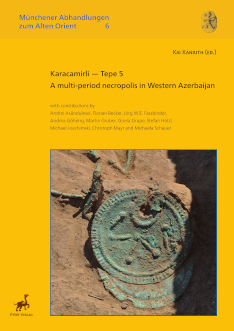
Kai Kaniuth (ed.)
Karacamirli – Tepe 5.
A multi-period necropolis in Western Azerbaijan.
Münchener Abhandlungen zum Alten Orient — Band 6
Format: 30 x 21 cm — Hardcover
Umfang: 358 Seiten, mit 348, meist farbigen Abbildungen im Text
ISBN: 978-3-935012-44-7
Preis: 65,00 €
© PeWe-Verlag 2020
Mit Beiträgen von Andrei Asăndulesei, Florian Becker, Jörg W.E. Fassbinder, Andrea Göhring, Martin Gruber, Gisela Grupe, Stefan Hölzl, Michael Joachimski, Christoph Mayr und Michaela Schauer
Der 6. Band der MAAO-Reihe beschreibt die Ergebnisse von zwei Grabungskampagnen auf dem Karacamirli Tepe 5, einem kleinen Hügel in der Nähe des Südufers des Flusses Kura im Bezirk Schamkir, Aserbaidschan. Der Ort wurde erstmals im 5. Jahrtausend v. Chr. besiedelt, aus dem mehrere Gruben mit Keramik und Obsidian untersucht werden konnten. Nach der Mitte des 2. Jahrtausends v. Chr. wurde Tepe 5 wiederholt als Begräbnisstätte genutzt. Insgesamt wurden 46 Gräber, beginnend mit der Spätbronze-/Früheisenzeit, über Bestattungen aus der Spätantike bis hin zum 14. Jh. n. Chr., dokumentiert. Ihre archäologische Diskussion bildet den Kern des Bandes. Eine Reihe von 21 Radiokarbondatierungen, eine anthropologische Studie mit Isotopendaten sowie ein umfassendes Programm chemischer Analysen (mit tragbarem XRF) von Obsidian-, Keramik- und Metallfunden tragen dazu bei, eine der detailliertesten Datenreihen über Bestattungen im Südkaukasus zu erstellen.
With contributions by Andrei Asăndulesei, Florian Becker, Jörg W.E. Fassbinder, Andrea Göhring, Martin Gruber, Gisela Grupe, Stefan Hölzl, Michael Joachimski, Christoph Mayr and Michaela Schauer
The 6th volume of the MAAO series details the results of two seasons of excavation carried out on Karacamirli Tepe 5, a small hill near the southern bank of the river Kura in Shamkir District, Azerbaijan. The site was first occupied in the 5th millennium BC, from which several pits containing pottery and obsidian could be studied. After the mid-2nd mill. BC, Tepe 5 saw repeated use as a place of burial. Altogether 46 graves, starting with the Late Bronze / Early Iron Age, continuing with interments from Late Antiquity and concluding with the 14th cent. AD, were documented. Their archaeological discussion forms the core of the volume. A series of 21 radiocarbon dates, an anthropological study including isotope data, as well as a comprehensive programme of chemical analysis (with portable XRF) targeting obsidian, ceramic and metal finds contribute to produce one of the most fine-grained sets of burial data available from the Southern Caucasus.